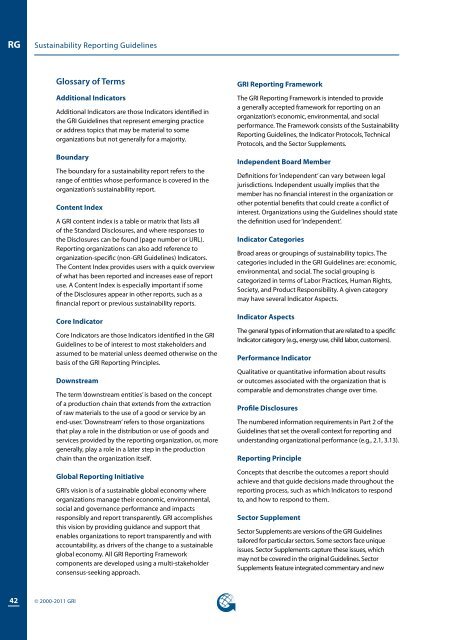G3.1 Sustainability Reporting Guidelines - Global Reporting Initiative
G3.1 Sustainability Reporting Guidelines - Global Reporting Initiative
G3.1 Sustainability Reporting Guidelines - Global Reporting Initiative
Create successful ePaper yourself
Turn your PDF publications into a flip-book with our unique Google optimized e-Paper software.
RG<br />
<strong>Sustainability</strong> <strong>Reporting</strong> <strong>Guidelines</strong><br />
Glossary of Terms<br />
Additional Indicators<br />
Additional Indicators are those Indicators identified in<br />
the GRI <strong>Guidelines</strong> that represent emerging practice<br />
or address topics that may be material to some<br />
organizations but not generally for a majority.<br />
Boundary<br />
The boundary for a sustainability report refers to the<br />
range of entities whose performance is covered in the<br />
organization’s sustainability report.<br />
Content Index<br />
A GRI content index is a table or matrix that lists all<br />
of the Standard Disclosures, and where responses to<br />
the Disclosures can be found (page number or URL).<br />
<strong>Reporting</strong> organizations can also add reference to<br />
organization-specific (non-GRI <strong>Guidelines</strong>) Indicators.<br />
The Content Index provides users with a quick overview<br />
of what has been reported and increases ease of report<br />
use. A Content Index is especially important if some<br />
of the Disclosures appear in other reports, such as a<br />
financial report or previous sustainability reports.<br />
Core Indicator<br />
Core Indicators are those Indicators identified in the GRI<br />
<strong>Guidelines</strong> to be of interest to most stakeholders and<br />
assumed to be material unless deemed otherwise on the<br />
basis of the GRI <strong>Reporting</strong> Principles.<br />
Downstream<br />
The term ‘downstream entities’ is based on the concept<br />
of a production chain that extends from the extraction<br />
of raw materials to the use of a good or service by an<br />
end-user. ‘Downstream’ refers to those organizations<br />
that play a role in the distribution or use of goods and<br />
services provided by the reporting organization, or, more<br />
generally, play a role in a later step in the production<br />
chain than the organization itself.<br />
<strong>Global</strong> <strong>Reporting</strong> <strong>Initiative</strong><br />
GRI’s vision is of a sustainable global economy where<br />
organizations manage their economic, environmental,<br />
social and governance performance and impacts<br />
responsibly and report transparently. GRI accomplishes<br />
this vision by providing guidance and support that<br />
enables organizations to report transparently and with<br />
accountability, as drivers of the change to a sustainable<br />
global economy. All GRI <strong>Reporting</strong> Framework<br />
components are developed using a multi-stakeholder<br />
consensus-seeking approach.<br />
GRI <strong>Reporting</strong> Framework<br />
The GRI <strong>Reporting</strong> Framework is intended to provide<br />
a generally accepted framework for reporting on an<br />
organization’s economic, environmental, and social<br />
performance. The Framework consists of the <strong>Sustainability</strong><br />
<strong>Reporting</strong> <strong>Guidelines</strong>, the Indicator Protocols, Technical<br />
Protocols, and the Sector Supplements.<br />
Independent Board Member<br />
Definitions for ‘independent’ can vary between legal<br />
jurisdictions. Independent usually implies that the<br />
member has no financial interest in the organization or<br />
other potential benefits that could create a conflict of<br />
interest. Organizations using the <strong>Guidelines</strong> should state<br />
the definition used for ‘independent’.<br />
Indicator Categories<br />
Broad areas or groupings of sustainability topics. The<br />
categories included in the GRI <strong>Guidelines</strong> are: economic,<br />
environmental, and social. The social grouping is<br />
categorized in terms of Labor Practices, Human Rights,<br />
Society, and Product Responsibility. A given category<br />
may have several Indicator Aspects.<br />
Indicator Aspects<br />
The general types of information that are related to a specific<br />
Indicator category (e.g., energy use, child labor, customers).<br />
Performance Indicator<br />
Qualitative or quantitative information about results<br />
or outcomes associated with the organization that is<br />
comparable and demonstrates change over time.<br />
Profile Disclosures<br />
The numbered information requirements in Part 2 of the<br />
<strong>Guidelines</strong> that set the overall context for reporting and<br />
understanding organizational performance (e.g., 2.1, 3.13).<br />
<strong>Reporting</strong> Principle<br />
Concepts that describe the outcomes a report should<br />
achieve and that guide decisions made throughout the<br />
reporting process, such as which Indicators to respond<br />
to, and how to respond to them.<br />
Sector Supplement<br />
Sector Supplements are versions of the GRI <strong>Guidelines</strong><br />
tailored for particular sectors. Some sectors face unique<br />
issues. Sector Supplements capture these issues, which<br />
may not be covered in the original <strong>Guidelines</strong>. Sector<br />
Supplements feature integrated commentary and new<br />
42<br />
© 2000-2011 GRI

















